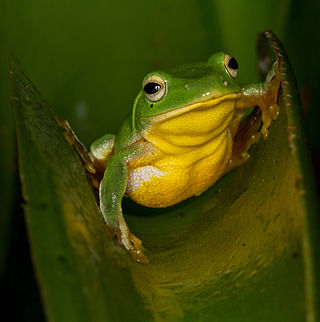
Arthroleptis variabilis is a species of frog in the family Arthroleptidae. It is found in the lowlands of eastern Nigeria, Cameroon, Equatorial Guinea, Gabon, the Central African Republic, the Republic of the Congo, and the Democratic Republic of the Congo. Earlier records west from Nigeria refer to other species, including Arthroleptis krokosua described in 2008. Common names Buea screeching frog and variable squeaker frog have been coined for it.
Hyloxalus bocagei is a species of frog in the family Dendrobatidae. It is found on the northeastern side of the Andes in Ecuador and in Colombia. The specific name bocagei honors José Vicente Barbosa du Bocage, a Portuguese zoologist. Common name Bocage's rocket frog has been coined for this species.

Hyloxalus elachyhistus is a species of frog in the family Dendrobatidae. It is found in southern Ecuador and northern Peru, in the Huancabamba Depression and south to Cajabamba Province.
Hyloxalus fuliginosus or the Quijos rocket frog is a species of frog in the family Dendrobatidae. It is endemic to Ecuador where it is known from the Amazonian slopes of the Andes in the northern Ecuador, with some sources reporting it from Colombia and Venezuela.
Hyloxalus infraguttatus is a species of frog in the family Dendrobatidae. It is found on the Pacific slopes of Ecuadorian Andes at elevations of 70–1,500 m (230–4,920 ft) asl.

The Cauca poison frog is a species of frog in the family Dendrobatidae. It is endemic to Colombia.
Pristimantis ceuthospilus is a species of frog in the family Strabomantidae. It is endemic to northern Peru and occurs on the western slopes of the Cordillera de Huancabamba and the Pacific slope of the Cordillera Occidental. There are also as yet unconfirmed records from southern Ecuador. The specific name ceuthospilus, from Greek keuthos ("hidden") and spilos ("spot"), refers to the yellow spots in the groin and thighs that remain hidden when the frog is sitting. Common name Wild's robber frog has been coined for it.
Pristimantis rhodoplichus, also known as the Canchaque robber frog, is a species of frog in the family Strabomantidae. It is found in the Andes of southern Ecuador and northern Peru. The specific name rhodoplichus, from the Greek rhodon and plichas, refers to the rose-red color of the hidden surfaces of its thighs.
Niceforonia lucida is a species of frog in the family Strabomantidae. It is endemic to Peru and known from the Cordillera Central west of the Apurímac River in the Ayacucho Region. Common name Cannatella's Andes frog has been coined for it. The specific name lucida refers to distinctive coloration of this frog relative to frogs in the genus Phrynopus, the genus where this species was initially placed. However, later studies have moved it to other genera where its colors are less distinctive.
Lynchius nebulanastes is a species of frog in the family Strabomantidae. It is endemic to north-western Peru where it is known from the vicinity of its type locality, El Tambo, on the western slope of the Cordillera de Huancabamba, Piura Region. Common name Canchaque Andes frog has been coined for it.
Lynchius parkeri, also known as Parker's Andes frog, is a species of frog in the family Strabomantidae. It is found in northern Peru and southern Ecuador. The specific name parkeri honors Hampton Wildman Parker, English zoologist and herpetologist.
Telmatobius ignavus is a species of frog in the family Telmatobiidae. It is endemic to the Cordillera de Huancabamba in the Department of Piura, Peru. Common name Piura water frog has been coined for it.
Telmatobius niger is a species of frog in the family Telmatobiidae. It is endemic to the Andes of Ecuador, with records from both Amazonian and Pacific versants. Last seen in 1994, it is feared that this species may be extinct. Common name black water frog has been coined for it.
Cornufer browni is a species of frog in the family Ceratobatrachidae. It is endemic to Papua New Guinea. It has been observed between 100 and 200 meters above sea level and between 1100 and 1300 meters above sea level.

Pseudophilautus decoris, commonly known as the elegant shrub frog, is a species of frogs in the family Rhacophoridae. It is endemic to Sri Lanka.
Pseudophilautus mittermeieri, commonly known as Mittermeier's shrub frog, is a species of frog in the family Rhacophoridae. It is endemic to Sri Lanka.

The Taipei tree frog is a species of frog in the family Rhacophoridae. It is endemic to central and northern Taiwan. It is a medium-sized tree frog; females are 4.5–5.5 cm (1.8–2.2 in) in snout-vent length, and males are slightly smaller 3.5–4.5 cm (1.4–1.8 in).

Hyloxalus is a genus of poison dart frogs, family Dendrobatidae. The genus is distributed in Central and South America, from Panama south to Peru, along with Venezuela, Colombia, and Ecuador. They also inhabit the eastern foothills of the Andes in Bolivia to Venezuela, east to the upper Amazon Basin.
Pseudophilautus schneideri is a species of frogs in the family Rhacophoridae, endemic to Sri Lanka. People have seen it in only a few places: Kudawa, Pituwela, and Kanneliya. People have seen it between 1100 and 1400 meters above sea level.

Nyctibatrachus radcliffei, also known as Radcliffe's night frog or the Thiashola wrinkled frog, is a species of frog in the robust frog family Nyctibatrachidae. It was described in 2017, along with six other species in its genus, by the herpetologist Sonali Garg and her colleagues. A medium-sized frog for its genus, it has an adult male snout–vent length of 32.8–38.3 mm (1.29–1.51 in). It is mainly reddish-brown, with a light flesh-red coloured underside, light brown limbs, and dark grey hands and feet. When preserved in ethanol, it is mostly dark grey, with grayish-white undersides.







